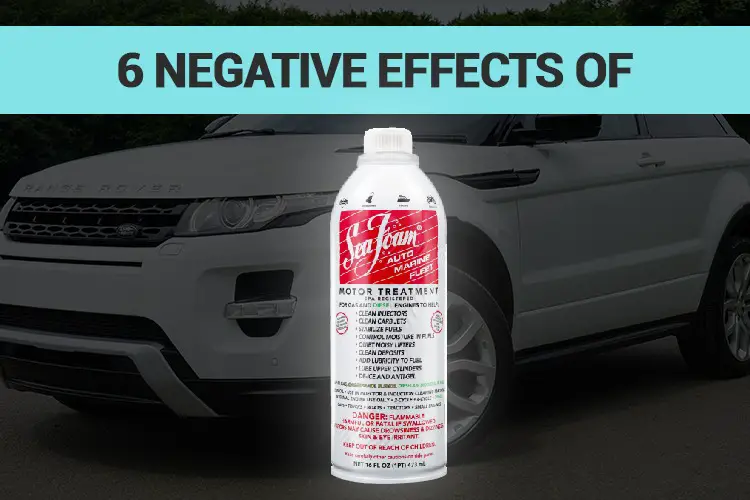Car owners have used Seafoam Motor Treatment for years to clean out the engine and eliminate carbon buildup. But have you ever wondered if Sea Foam can damage your engine?
While Seafoam does work, it can potentially damage your catalytic converter and possibly cause damage to other components in your engine if not used correctly.
This article will tell you the truth about seafoam.
What Is Seafoam ?

Seafoam is a petroleum product that contains polyethylene, which acts like an oil. The Seafoam chemical dissolves the gunk in your engine and cleans out the cylinders, leaving them fresh and new. This effect lasts long enough to drive the car three or four times, but then carbon begins to build up again and repeat the process.
Seafoam motor treatment is not designed as a running additive; it only works when the car engine is turned off and remains warm. After five minutes of operation, Seafoam becomes ineffective. This means that you should only use Seafoam once every three or four weeks to avoid damaging your catalytic converter.
What Is Seafoam Used For?
Seafoam is a unique chemical formulation developed as an alternative to the highly toxic and banned polyisbutylamine reed-valve cleaners.
Over time, Seafoam breaks down varnish and gum deposits in engines. This restores lost power and fuel economy. It also cleans injectors, promoting precise fuel delivery.
Besides, it prevents future deposits on valves and rings and provides maximum lubrication of vital engine parts.
6 Seafoam Negative Effects- The Truth About Seafoam
Many car owners use a can of Seafoam in their cars at some point. Car manufacturers even recommend using it, but I have found 6 negative effects of seafoam to your car engine as below:
1. It won’t help your engine as much as you think
Seafoam is a lubricant that does not combust. Because of this, it cannot create more power. Seafoam’s main job is to clean the intake valves and combustion chamber by separating the gasoline and oil, which can build up and interfere with an engine’s performance.
2. It can hurt the oxygen sensors
The engine’s sensors are a crucial element of your car’s emission system. Seafoam will clean these sensors and temporarily give you a check engine light. The sensor is what controls your car’s fuel mixture, so it needs to be reading correctly to pass emissions tests or diagnostic checks that mechanics run on your car.
3. It will clog up your engine’s gaskets and valves
Seafoam is a thick liquid that coats everything it touches, so once you’ve poured some into the tank, your engine will be covered in its residue. This can cause the buildup of dirt and debris on your engine’s gaskets, valves, piston rings, and oxygen sensors. Eventually, these things will lead to problems with your car’s performance.
4. It is bad for fuel injectors
Some cars have fuel injectors in the throttle body, while others have them in the intake valves. Seafoam will pour into the crevices of your car’s engine and make a giant mess, clogging up these essential engine parts. The buildup will only get bigger with time if you don’t clean it out right away.
5. It can destroy your car’s catalytic converter
Using Seafoam can make your car run rich, which means you’ll get the wrong amount of fuel in your engine. It will cause the excess gas to burn in your catalytic converter and damage it beyond repair. You cannot simply clean this part with a cleaning agent like an oxygen sensor or gasket because it is more complex. There are different components in the catalytic converter that are most likely made of precious metals, so you shouldn’t be trying to clean it with anything anyway.
6. The fumes are harmful to humans and animals too
Seafoam Alternatives
You shouldn’t use any cleaning agent on your car’s engine because they’re hard to control. Instead, run a gallon of fuel injector cleaner through the gas tank every 3K to 5K miles.
In addition, consider cleaning or changing your air filter and oil, as well as having a professional do a complete tune-up on your car. Using this approach regularly won’t have problems with dirty or clogged filters because they’ll be “new” again.
You can also change your engine’s oil every 3K to 5K miles instead of the standard 7K miles. If you do this, be sure to switch from conventional oil to synthetic oil because it lubricates better and is more heat-resistant than conventional oil. You might also want to consider using a reputable brand name oil such as Mobil 1, Valvoline, or Castrol.

Mobil 1 – Motor Oil

Valvoline High Mileage

Castrol 03102
Does Sea Foam Actually Work?
Not really. It’s just a big ol’ can of compressed air. But it does have its uses – like cleaning out your carburetor or unclogging a fuel line. Basically, anything that needs a good blast of air will do the trick with Sea Foam.
So if you’re looking for a quick and easy way to clean out your engine, and don’t care about its negative effects, give Sea Foam a try. Just don’t expect miracles. It’s not some sort of magic potion that will make your car run like new again. But it can help keep things running smoothly – and that’s always a good thing.


Leave a Reply